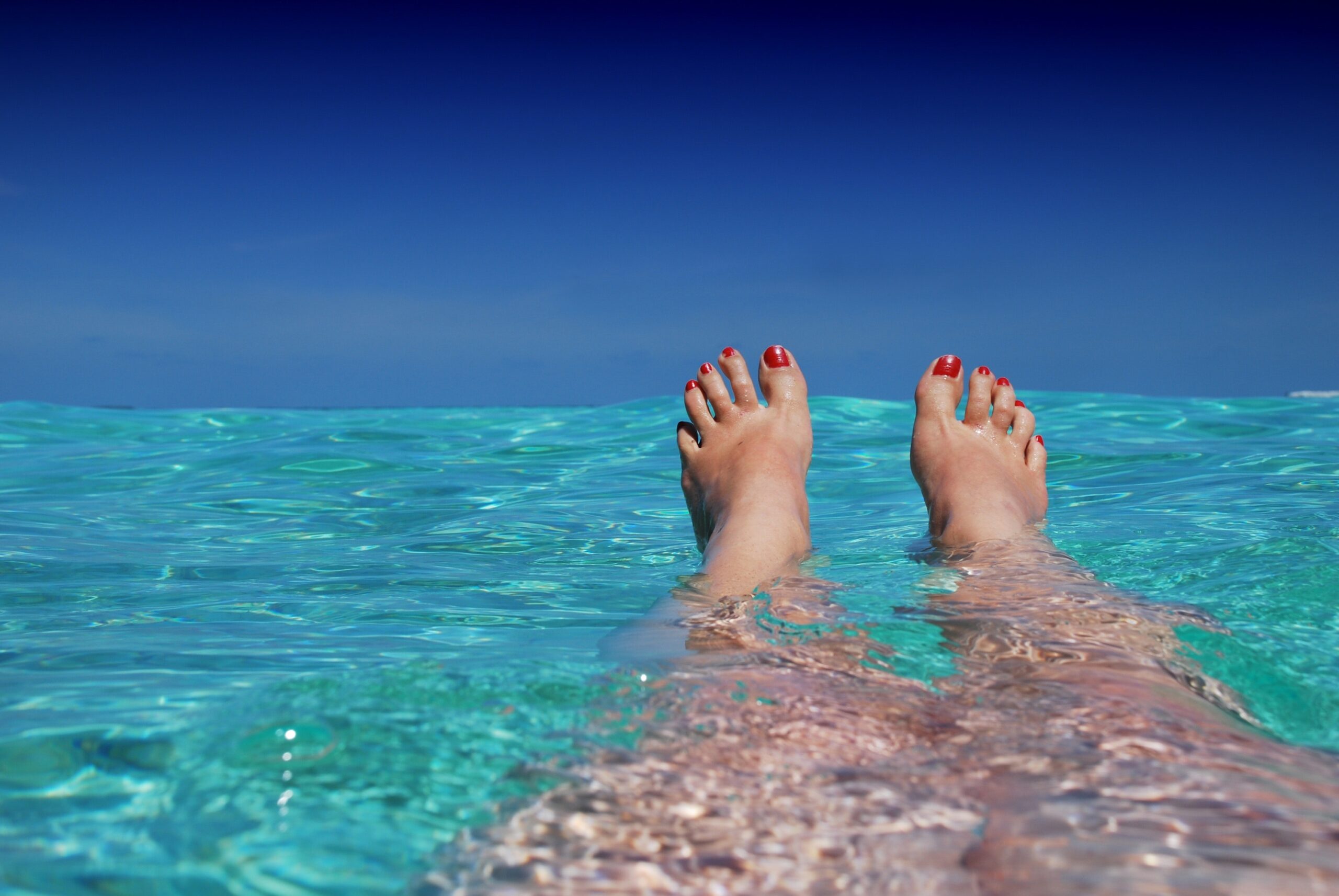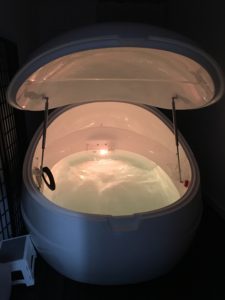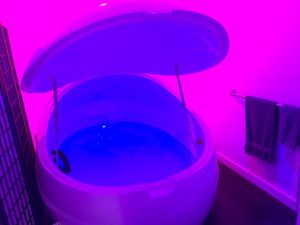

My clients are always asking me about alternative interventions to help with their symptoms. When you have a chronic physical or mental illness, it probably feels like you’ve tried just about everything the traditional medicine model has to offer – OR – they just don’t have much to offer due to not adequately understanding your symptoms. In either case, it can ultimately lead to you being your own advocate and interventionist. Be it acupuncture, massage, reiki or ‘cupping’, It can get daunting doing the research and putting money and time into trying out new methods. I like to try out interventions so that I can give my clients my honest and educated feedback about what I think might benefit them and what I think is nothing more than a fad. Today, I am here to share with you Here’s What Happened When I Tried Flotation Therapy so that you can learn from my experience and decide for yourself, if Flotation Therapy could help you.
What is flotation therapy?
Flotation Therapy, more formally referred to as flotation restricted environmental stimulation therapy (REST) is also known as ‘sensory deprivation’ therapy, ‘floating’ or ‘salt tank therapy’. Floating, is the practice of floating in an enclosed tank of epsom saltwater. You can float in the darkness or with colored lights on and you can listen to meditation style music or float in complete silence. The tank is an egg shaped ‘pod’ that has a handle on the inside and outside so it can easily be opened from either side. You float completely naked, so you have to shower prior to floating to wash off any oils or chemicals that might disrupt the tank and after to clean the salt off your skin and hair.
Floating was invented in the 1950’s by neuroscientist Dr. John Lilly in the United States. The idea behind this strategy was to deepen relaxation through restricting environmental stimulation and inducing the theta brainwave frequency, commonly known as the stage we enter just before falling asleep or during hypnosis. Theta induced states are known to increase creativity, relaxation, REM (Restorative) states similar to our first stages of falling asleep and emotional awareness. The idea is that the reduction in sensory stimulation will reduce the stress and workload of the central nervous system and inhibiting the autonomic nervous system response, aka ‘fight or flight’ and inducing the parasympathetic response, aka ‘relaxation’.
Research behind floating has yielded positive results in small studies on areas such as improving mood states and muscle soreness in elite athletes and stress reduction through lowering cortisol levels and blood pressure.
what is it like floating?
I floated for the first time at Best Day Fitness here in St. Petersburg, FL. They did allow me to float for free as part of a special for providers in the medical field. A typical float is 95$ for 1 hour and they have specials and packages beyond that to help reduce the cost.
When I got there, I took my shoes off (it’s a barefoot gym) and visited Chris, the owner, at the desk to let him know I was there for my appointment. Chris was very welcoming and has a warm smile. He took me over to the float room and started his VERY thorough explanation and walk-through of the float process. He knew it was my first time and took a lot of extra care in making sure all the bases were covered and he had answered all of my questions.
The first step is you push on these wax ear plugs – not the kind you put in your ear canal, but the kind you smush over your ear opening to prevent ambient noise and salt water from getting in. After you put the ear plugs on, you undress and get into the shower, which had a sensor above the door to let Chris know you were almost ready to get into the pod and that you didn’t break the rules and get in without taking a shower, which can result in costly cleaning fees.
After showering, you open the pod (unless its open already) and step into the water. The water is kept at skin temperature which is around 95 degrees and is perfectly comfortable. It is infused with almost 1000lbs of epsom salt so as soon as my bottom hit the bottom, my legs immediately floated to the top, which was an interesting and new feeling. As some of you know, I suffer from chronic pain, fatigue, brain fog and insomnia due to my lupus, fibromyalgia and arthritis symptoms, so my expectation going into this was that it might help my pain, help me sleep better and/or help me reduce my overall stress and anxiety. I hadn’t done any research prior to floating, because I didn’t want to be too swayed one way or the other, but when you have a chronic illness there is always the hope that it will help reduce symptoms.
Chris had explained to me that on the left was a button to control the light and on the right was a button to control the sound. He also explained that the closer you are to the speakers, which I believe are under the water line, the louder the sound is and the further away from the speakers you float, the quieter it will get. When I laid back to begin my float, I couldn’t hear a thing so I floated my head toward the speakers and sure enough, there was the music. I played with the lights and discovered I liked the blue light best, but ultimately turned them off once I got oriented because I wanted the full sensory-free experience.
Chris also explained that due to the buoyancy of the water placing the body in a natural posture (to which most of us aren’t accustomed) it can lead to neck stiffness and soreness the first few floats. He recommended some stretches and exercises to alleviate this and there is a neck pad you can lay on if those ultimately don’t work. I ended up using the neck pad because the stiffness was so intense, I almost couldn’t stand laying there. The neck pad worked wonders, though, and I floated on.
Once you get your bearings and a feel for the environment, which took me about 20-30 minutes, you begin to relax. For me, this was fairly difficult because I get uncontrollable muscle movements, which in a float tank that is free of any other stimuli, became very apparent. As soon as I got into a relaxed state, my arm would jerk or my hands would clench slightly, jerking me out of that relaxation and back into the present. There were a couple times that I was able to slip into a very, very deep state of ‘zen’ or relaxation and I must say, it was the most relaxed I think I’ve ever felt. At times when I was ‘in the zone’, I couldn’t tell where my body appendages ended and the water began. You know you’re ‘there’, but can’t necessarily feel things in time and space. My hands, for instance, were seemingly not there. I would wiggle my fingers and sure enough, there they were, but what an interesting feeling for someone who has experienced pain every day for the past 5 years. Was my pain gone completely? No, but I had a sense that it had been reduced to a very, very dull level that, to me, was just as good as having none at all.
Once the session was over, Chris turns on the water jets to help wake you up and alert you to get out of the tank and cleaned up. Once I went to stand up, my whole body felt heavy and I had a difficult time getting out of the tub. I had to lean my weight on the outside of the tub and use the energy I had left to swing my leg over the side. Once I was showered, it seemed the heaviness started to fade and I was ready to check out.
so how did I feel after floating and would i recommend it to others?
I should mention first that prior to floating I felt pretty crappy: I had a headache, fatigue and all over pain and achiness. After floating my headache returned and mostly, I felt tired – like, having-a-hard-time-thinking-and-conversing, tired. I went home and was rendered useless for the rest of the day, starting with a two hour nap. Was I relaxed? definitely. Did it help with my pain and fatigue? While I was in the tank, yes. After I was home it seemed business as usual. By the end of the day I was in my usual mix of throbbing and aching pains and was disappointed the effects hadn’t lasted longer. I even had a sort of emotional release after I woke up from my nap, characterized by feeling overwhelmingly sad. I cried it out and then felt ok, but I’m not sure if this was a result of the float or my own response to feeling fatigued.
Would I recommend the tank to others? Sure! I think everyone should try new things as long as they don’t pose any risk to their health and they do their own research. One thing I will recommend it for is stress reduction. The relaxation state I experienced alone was worth it. Sure, we’re always hoping for that magic thing that will take all the pain and discomfort of chronic illness away, but I realize that is an unrealistic expectation that I had going into this experience. I plan to float a few more times and see if any of the effects change with continued use.
what else do i need to know about floating?
Be wary of any float spas that promise unrealistic results. There are many reasons one might consider floating, but the main groups of people who tend to be advertised to are people who are sick, people who are stressed out, people who want to enhance physical performance and people who want to explore inner growth and mind exploration. Regardless of which group you may fall into, know that even studies showing results in certain areas don’t necessarily mean you will get the same results. Managing your expectations and going in with an open mind are recommended. A study was done that compared marketing tactics of float spas around the world and found that claims made by float companies were often unsubstantiated by evidence.
This study outlines the claims that DO have research to back them up, such as:
- lowering stress hormones
- normalizing blood pressure
- magnesium benefits by relaxing muscles and lowering systolic BP
- increased restoration after training and competition (muscles/ fitness)
- heightened theta brain wave activity
- reduced chronic pain
- reduced pain relating to tension headaches
- reduction in anxiety and depression
- helping quit smoking
- enhanced sleep quality and reduced insomnia
- feelings of weightlessness (based on self reporting)
- increased originality and alters states of consciousness (relating to learning and creativity)
- increased intuition, imagination and focus on the ‘here and now’
- enhancing psychotherapy methods and increased self development
- improved athletic performance
…while claims with little to no research to back them up were:
- changes in endorphin levels effecting pain
- enhanced nutrient uptake and digestion
- magnesium being absorbed through the skin
- enhanced immune system
- weight loss
- pregnancy symptoms
- psoriasis (studies using floating REST specifically have not been done, but there is some evidence that using salts in the bath could have benefits for psoriasis)
- deepening meditation practice
- increased sensory awareness (although one study did show an increased sensitivity to pain)
All in all, I think if you are looking to experience relaxation, definitely give floating a try. The Best Day Fitness center in St. Petersburg is having a BOGO introductory offer so you can get the first two floats at essentially half price to try it out. Do not float if you have any medical concerns, open wounds or you’ve consulted with your doctor and they have recommended against it.
Amanda Pratt, LCSW
amanda@imaginelifetherapy.com
727-939-5037
Want to learn more? Sign up for our email list below to get premium access to online courses, new blog posts and educational content! Once you sign up, you will get our FREE GIFT: The Stress Reduction Activities Worksheet!

